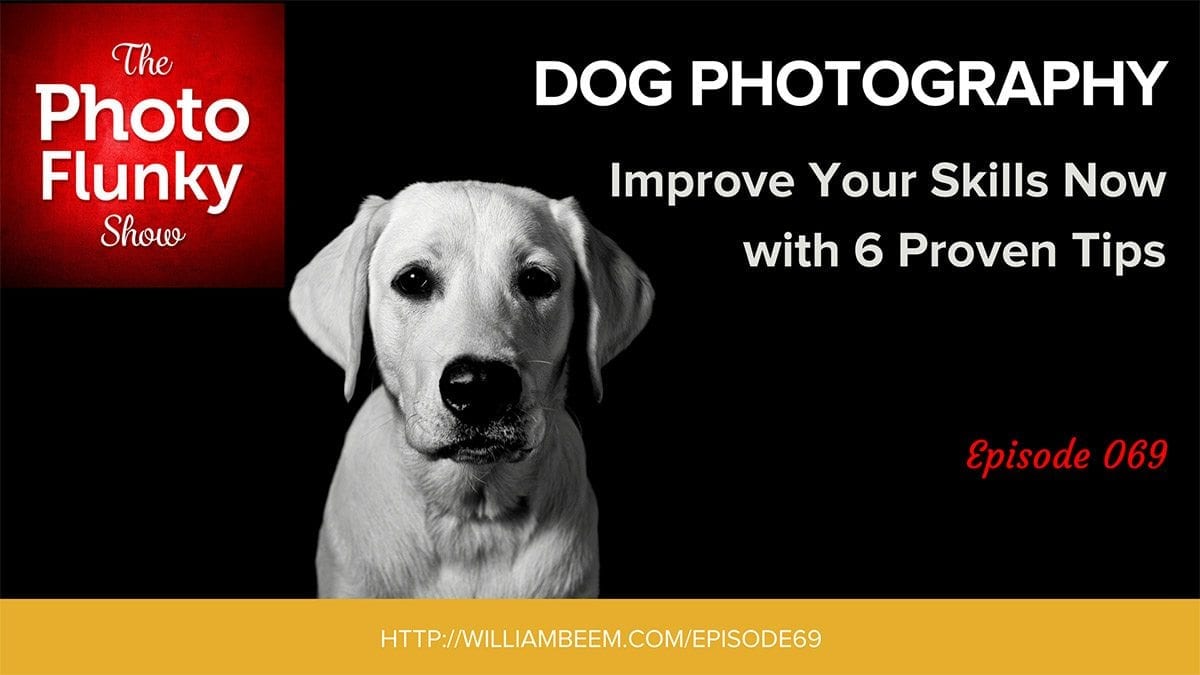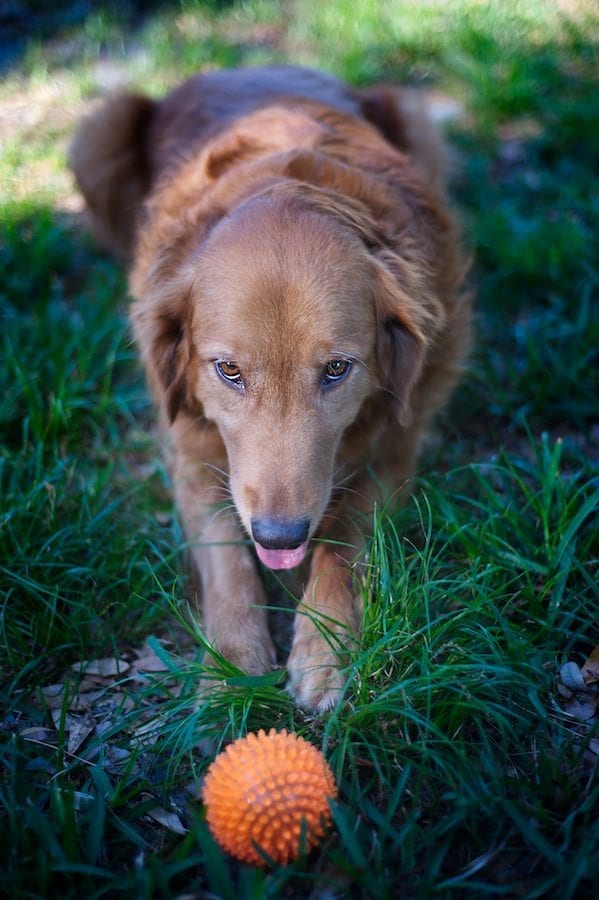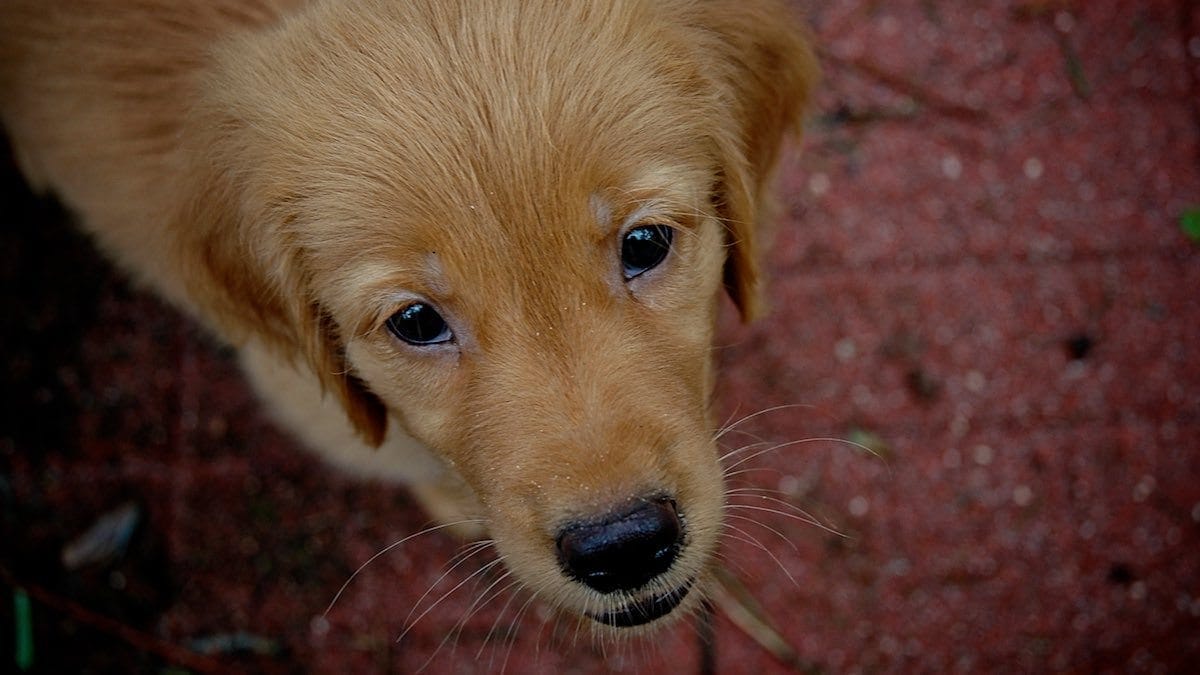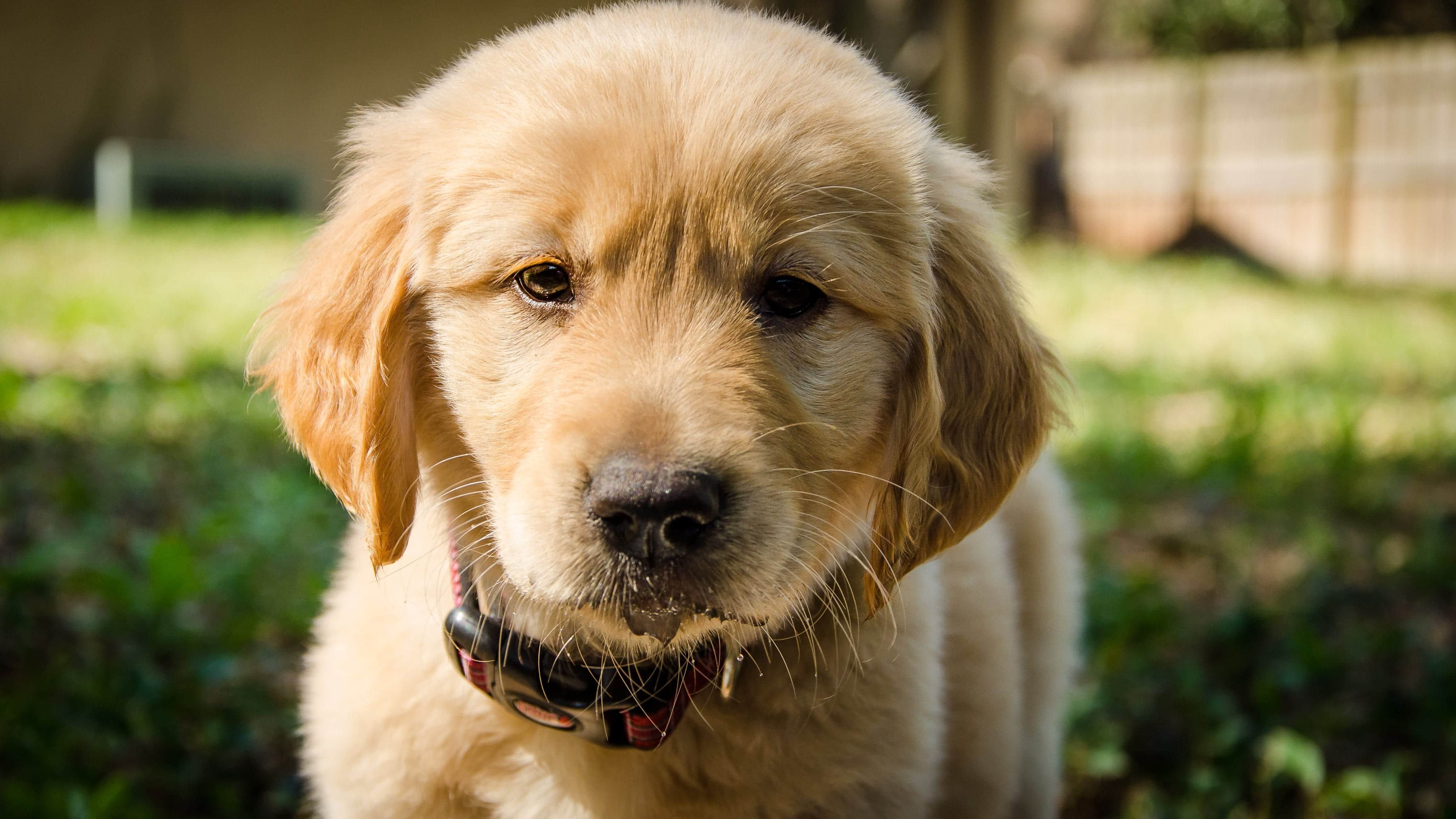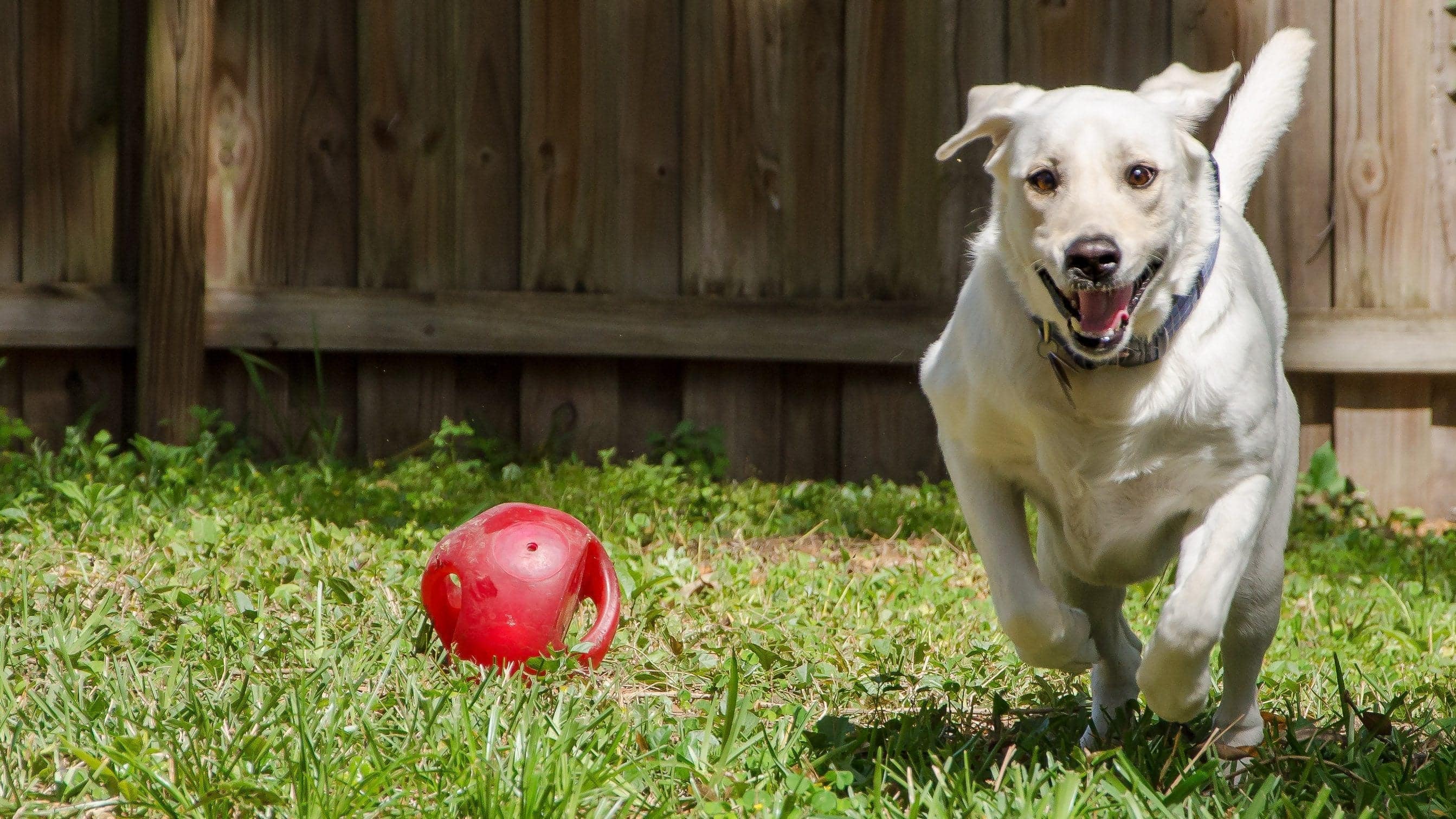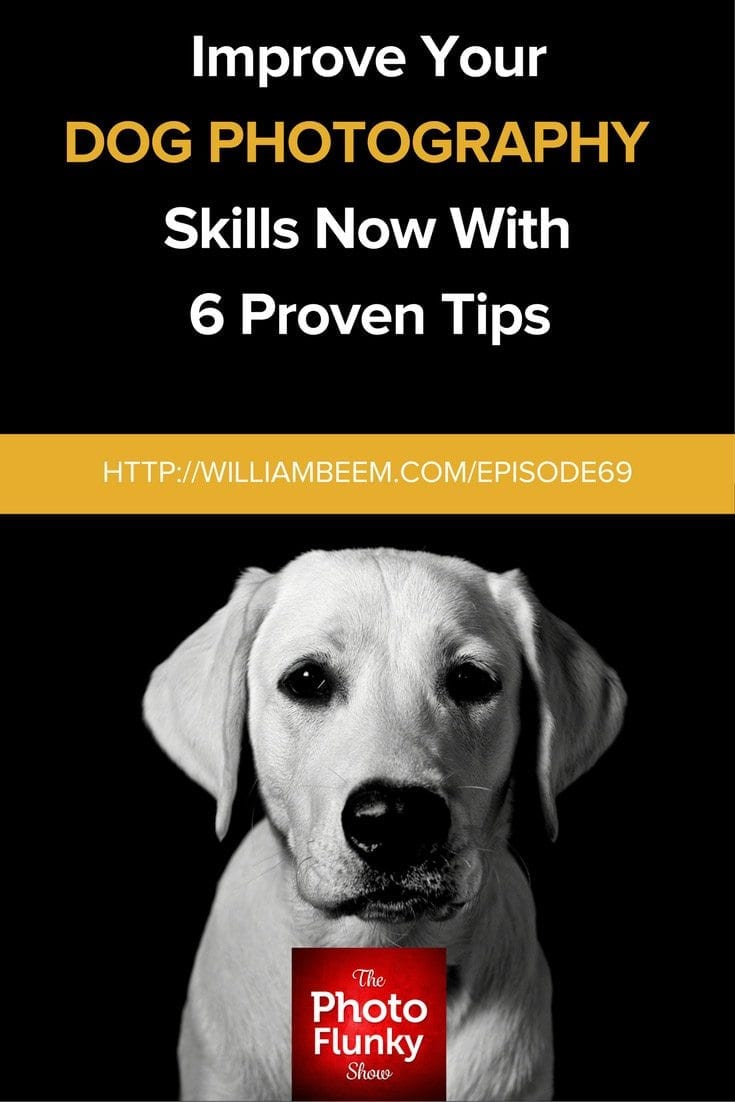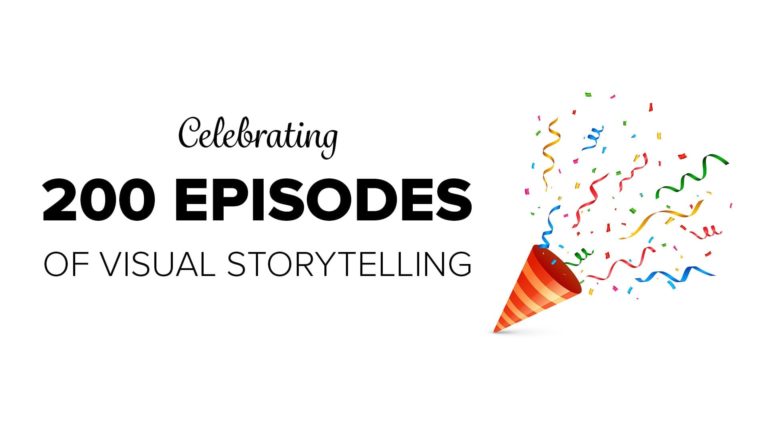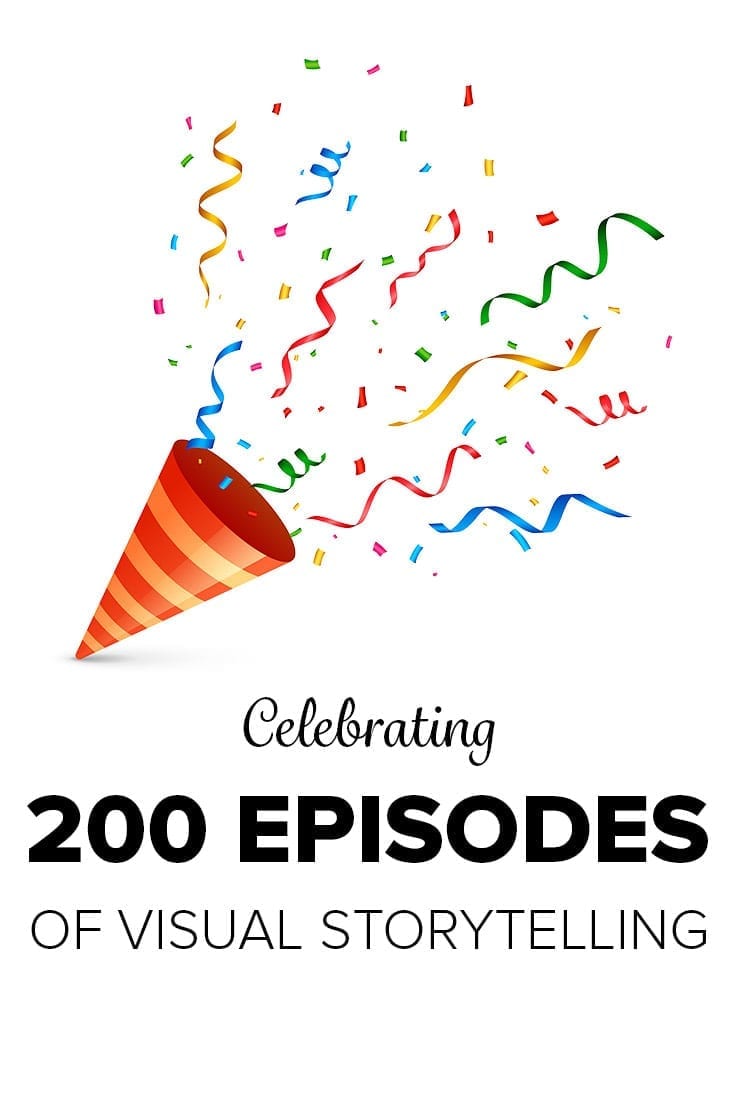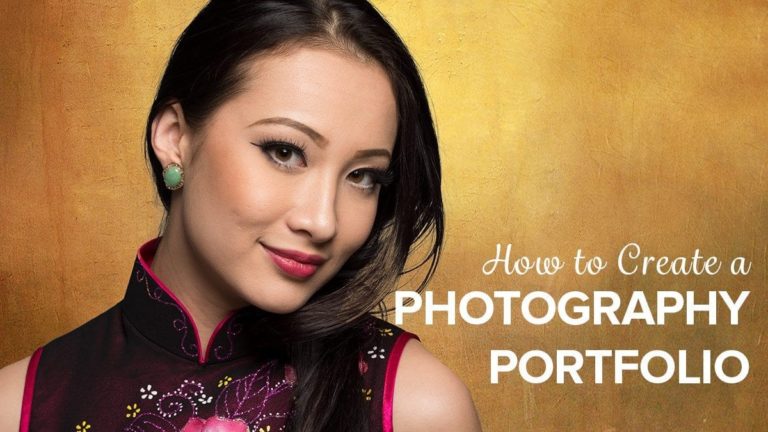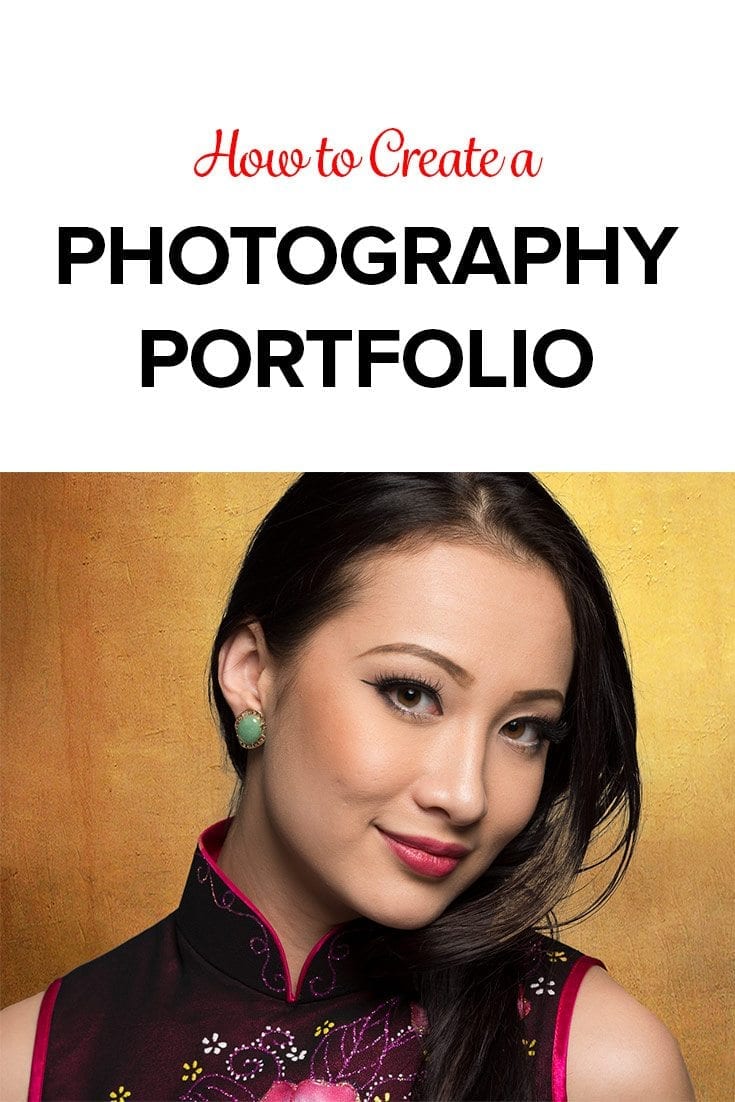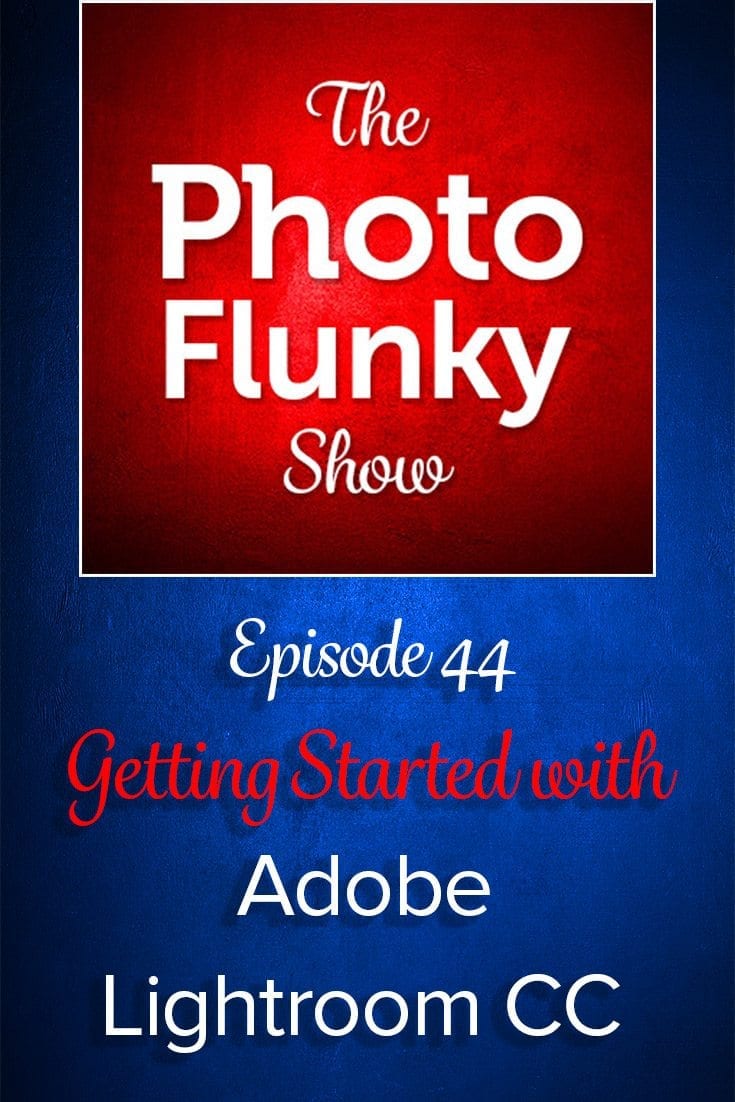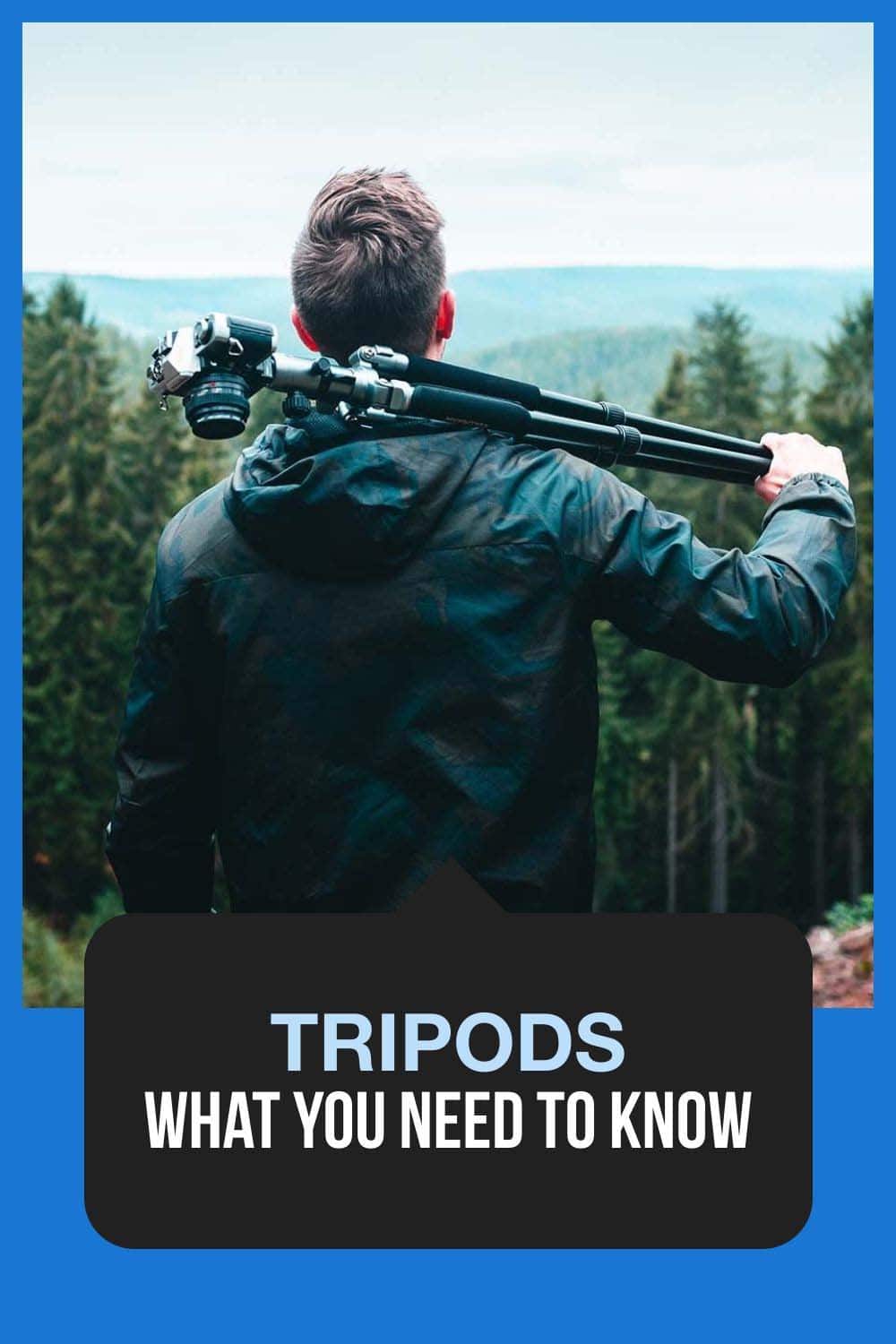Affiliate Disclosure: We earn a commission if you purchase through one of our links at no additional cost to you.
Dog Photography Tips for Your Family Pets
We don’t pretend to be dog photography experts, but we’ve spent a fair amount of time photographing our pets over the years, both young and old. With that experience in mind, we have six proven tips to help you get nice photos of your pets and have fun while shooting.
There are a few more bonus tips in the podcast that came up during the discussion, so please give it a listen.
1: Have Patience!
The average adult dog has the mentality of a three year old human. Keep your expectations realistic. They won’t have a long attention span before they get bored, distracted or otherwise become disengaged with your photos.
If you’re shooting puppies, expect their attention span to be even shorter.
For puppies, we recommend playing with them before the shoot to get them a bit tired. Not so tired that they need a nap, but a restful puppy is much easier to photograph than one trying to lick or eat your lens.
2: Know Your Purpose For the Photos
While I like to visualize my photos before the shot, Lee is much more comfortable getting photos as the moments come. There is merit to both ideas, but it’s hard to wrangle a puppy for a specific shot. You’ll save some frustration if you follow Lee’s example and get what the dog gives you.
Which approach you take depends upon why you want the photos. Are you taking shots of family pets, as we do? Do you want to capture your dog in a photo that shows off their personality, or do you want more of a portrait style shot? Maybe you want a shot of your dog with his favorite toy.
You can use your dog’s color to help determine where to shoot. Some dogs have great color contrast. Others, such as our Black Lab, seem to absorb light and the background becomes critical to get a decent shot.
3: Get Down on Their Level
For the most part, we see our dogs from above. It’s a pretty common point of view.
They’re cute, but getting down on their level can give you a photo with a perspective most people never see. If you want to take a nice photo, put your camera someplace interesting.
4: Prepare to Come Away Without a Shot
Any number of things can interfere with your dog photography session. The dog may not give you an interesting look. The weather may not be great. We often shoot in our back yard that hosts a number of oak trees. That means we get a lot of dappled light, making it difficult to get the shot we envision.
Sometimes you need multiple takes to get the shot you have in mind. If it doesn’t happen on the first three or four tries, your dog may no longer have an interest in performing for your camera.
I really like getting shots of our dogs running toward the camera. The problem is that there is a sweet spot where the dog is in the right spot for your composition.
Will the dog look into the lens with a happy smile and ears flapping? Most of the time, not in the spot where you need it to happen. Especially if it’s a puppy.
I tried this recently with our Golden Retriever puppy, Emma. Sometimes she looked the wrong way, as my daughter was running along-side to get her to perform. Emma often tumbled head over heels in the sweet spot. Then there were times I just didn’t nail the focus.
You only get so many tries with a shot like that one.
However, your circumstances may vary. Some shot may be better than no shot. In our case, we can try again if we don’t get the shot we want.
5: Get Engagement with the Camera
When you look at your dog photos, you want to see your dog looking back at you. Just as with portrait photography, the eyes are where you find the action.
One of the best ways to get that engagement is to have someone assist. It may be possible to do dog photography by yourself, but I wouldn’t recommend that as your first approach.
You take care of the photography. Let your assistant take care of engaging the dog’s attention and getting her to look toward the camera.
That may mean using squeaky toys or other noise makers. Some dogs work well with hand gestures. Others zero in on food or treats right away. A reward for the dog can reward the photographer with an intense look of concentration or excitement. However, it may also result in the dog jumping over you to get the treat in your assistant’s hand.
Use your own best judgment depending upon the personality of your subject.
6: Action is for Older Dogs
I won’t say you can’t get an action shot of your puppy, but our experience tells us that it’s much easier with an adult dog. Puppies are all over the place – physically and mentally. Our pups can start running toward us and get distracted along the way, tumble over, or just decide to stop and scratch something.
Older dogs are eager to please and you can get them to do the same action plenty of times before they lose interest.
Subscribe to The Photo Flunky Show
Thank you for listening to The Photo Flunky Show. Make sure you get every episode by subscribing.
iTunes – https://williambeem.com/itunes
Stitcher – https://williambeem.com/stitcher
Google Play – https://williambeem.com/googleplay
Blubrry – https://williambeem.com/blubrry
Transcript
THE PHOTO FLUNKY SHOW: Episode 69
Links to subscribe to the show:
You can find links to this episode and all of the other ones at photoflunky.com
iTunes: williambeem.com/itunes
Google Play Music: williambeem.com/googleplay
Stitcher Radio: williambeem.com/stitcher
Blubrry: williambeem.com/blubrry
Keep up with us on social media:
Twitter: @photoflunky
Facebook: William Beem Photography
YouTube: William Beem Photography
You can find links to this episode and all of the other ones at photoflunky.com and of course if you’d like to subscribe, we would love that. Go to at williambeem.com/itunes or williambeem.com/googleplay or williambeem.com/stitcher or even williambeem.com/blubrry
William: Hey, welcome toThank you very much for joining us on the Photo Flunky Show, episode sixty-nine.
Today we are going to give you our six best tips for dog photography. You probably didn’t know we were dog photographers, and honestly, we didn’t know either until we tried it recently.
Hi. My name is William Beem.
Lee: My name is Lee Beem.
William: And we are not professional dog photographers! Instead, we are people who have one dog and two puppies.
Lee: Yes.
William: I mean two little puppies. We are talking, one of them just turned nine weeks the day that we are recording this show – or is it tomorrow? And the other one is 12 days older. And our oldest dog is going to be five years old in June, so he’s settled down.
Lee: Somewhat.
William: It’s hard to believe that that dog is now the mature one!
Lee: Yeah, because really! He’s my baby!
William: Yeah, that one’s Milo. So anyways, we decided since we have puppies we need to have photographs of puppies, because that’s what we do. We take photographs.
Lee: Well, it was a great idea, wasn’t it?
William: Oh it was a fantastic idea. And before we tell you all about that idea, let me just tell you that show notes are going to be available at williambeem.com/episode69 and you’ll find a transcript of this show there for free.
Of course there are also links to subscribe to the Photo Flunky Show. You can find them there on the show notes page or you can go photoflunky.com and find this show and all of our other shows, plus links to subscribe. And before I forget, please make sure you get your free copy of Creative Portraits. That is my ebook that is available to you about the creative and colorful and non technical side of portrait photography. So if you want to get that, go to williambeem.com/freebook or you can use your phone and text the message CPBOOK to 33444. It will ask you for your email address. Once you give that, it will shoot it right off to you.
Of course that’s free and you can pass it around to a friend. We would be happy to hear your thoughts on it too.
Like I said, we have six tips. Basically it’s six things we’ve learned about photographing dogs. We are not going to call it pet photography, because we don’t have cats, goldfish and snakes and other types of pets. We have dogs.
Lee: Oh, we have snakes. They’re just not pets!
William: Well, there are snakes in the back yard. Not often, but it’s spring time so things are on the move so I’m just hoping gators don’t show up in the back yard.
Lee: Yeah, please!
William: We are in Florida.
Lee: You don’t sit in the back yard. I sit in the back yard and get down on the ground. So there are snakes.
William: There are snakes.
Lee has done most of the photography of our little pets. I’ve tried a few times out there. I’ve got some shots that I actually liked and enjoyed, but I think you’ve done better at this than I have.
Lee: I’ve taken a lot more shots than you have; it’s not that I’ve done better.
William: That’s true.
So the first thing that we’re going to advise you, particularly with puppies; not just with dogs in general, but with puppies, is to have patience.
Lee: Lots of patience.
William: Puppies have very short attention spans.
Lee: Yes.
William: Also, whatever you’re doing, you are the center of their being and they just want to come up to you and see what is that big thing you’ve got and can I lick that lens?
Lee: Or in Lola’s case – can I eat it?
William: Yeah, Lola is our black Lab. And just so we mention them. Milo is our oldest one and he’s a white Lab. Lola is the black Lab. And then we have Emma. She’s a Golden Retriever.
Lee: Yes.
William: Who loves her singing voice.
Lee: She does!
William: Alright, let me get back to what we’re talking about: patience. What have you found out about how much patience you need? How much time can you actually spend trying to photograph a dog before they just lose interest or are off to do something else?
Lee: You know, the first time I spent close to an hour, possibly a bit more than that. And I snapped off probably about 80 to 100 frames and I think I had two that were worth processing. I imported a few more and they just weren’t worth doing.
What I learned after that is that if you play with the dogs first and tire them out when they are that little – the easiest thing if you just really want a photo of the dog – get them tired and relaxed and while they are still awake and kind of cooling off or resting somewhere, that’s the best time to try and do it.
William: So they’re not running around. They are not coming up to you to try and lick the lens and they’ll actually stay put so you can get a shot.
Lee: They eventually get bored with what you have in your hand because it’s not interesting anymore if it sits around there for long enough.
William: The next item we have, as number two on our list, is know your purpose for the photos. For us, we are not trying to sell these; we are not trying to do portrait photography or pet photography for clients. These photos are for ourselves.
Lee: Yeah. These are family photos. It’s just like taking photos of your kids. We want nice photos, but these are not to go in a gallery somewhere or to be showcased. We’ll share them; we share with our friends and family.
William: As a matter of fact, we’ll put some up on the show notes page so you can see examples of what our cute little dogs look like.
Lee: Yes, they are really sweet!
William: You brought this one up. Know your purpose.
Lee: You do, because I have relaxed a lot more taking the photos and maybe that’s what helps give me more patience. It’s knowing that these are for us. There wasn’t some kind of pressure. I wasn’t trying to impress anybody. I was trying to get something for ourselves.
William: If you were – let’s say not necessarily for a client – but if you had a friend who said, “Oh I really want you to take photos of our dogs.” What would you say?
Lee: I would be happy to come and hang around with the camera. But I would make it very clear that I’m not a pet photographer. I’m going to do my best, see what I could get. It’s the same with taking baby photos. You might have to go back and have several attempts.
William: That’s one thing I wonder about pet photographers. I know we’ve watched a few folks who are doing pet photography and it is not something that I think I could do. Simply because it’s not like you can direct a dog, particularly a puppy. I think dogs, particularly older ones, you can get them to sit, you can get them to stay. Even if they are not well trained, you can kind of get them into a position where they will figure out, OK he wants me to wait here.
Lee: Yes.
William: Puppies don’t have that attention span and trying to do puppy photography if they are wide awake and romping around is just frustrating as can be!
Lee: Yeah and I mean even action photos can be difficult. Are we going to get onto that?
William: That’s actually our last one. We are going to get to that a little bit later on.
OK, the next tip we have, number three, is get down on their level. I’ve got one shot of one of our former dogs. I say former because he has since passed on. Zach. I shot him from above when he was just looking up at me. I really love that shot because he was young, he’s fresh faced and it just did a nice job of capturing his face. But for the most part, shooting dogs from above is not really all that interesting because you see them that way all the time.
Lee: You do. And I guess if you want to capture them as you see them, to remember how far down you were looking and then they are looking way up at you, that is really cute. I got one of Lola like that. It wasn’t planned. I just had the camera in my hand and as she sat she looked up at me and I just ….
William: You know what? I am not telling anybody don’t shoot them from above. Because if you’ve got a nice shot, I would say go ahead and take it. But the more interesting shots that we’ve captured have been down at their level.
Lee: Yes. I’ve literally being lying on my belly or crawling around on my elbows.
William: Yeah, we’re down there and of course for a puppy that means you want to play!
Lee: Which is why I eventually learned the hard way to play them first and then when they kind of settle down a bit, it depends on the breed of dog as well, I suppose and their personalities. But eventually they get tired and just before they start getting ready to sleep they just want to rest and they’ll go and lie somewhere and they don’t have the energy to get up and chase things anymore.
William: Yes, and also if you get down on their level, you’re getting into eye to eye point of view and you get their expressions in a way that I don’t think you get if they are tilting their head up and looking back up at you.
Lee: That’s right, yeah.
William: Particularly with puppies, it can be very hard to get a shot of them looking down on you.
Lee: Yes, just because of their size.
William: Yeah, I think maybe if you’ve got a small point and shoot or an iPhone or something like that, maybe you can do that. And that may be an interesting shot. But if we’re talking about doing these photos with our DSLR’s and they are just too big. At least for the puppies that we have. We got them at eight weeks – eight, nine, ten weeks old and at that age they are not very tall.
Lee: No, they are not.
William: This is probably the best advice that we are going to have. Number four is be prepared to come away with nothing.
Lee: Yes, it can happen and I am willing to be out there. I think what I did last week when I got most of our photos, I eventually just had the camera battery charged, I had a lens on the camera and I had my camera lenses right near the door where we take them in and out. There were times where I would just see them. Once I had to change the lens and the closest thing I had that was fast enough was the 50 mm and that’s the one I used inside. Other than that, I would just grab the lens and walk around with the camera. I’ve got a shoulder strap that goes across the body and I’d wear the camera on my back and just walk around ready with it.
William: I think that’s part of the patience also. You’ve got to be ready with your camera because there have been a number of times we’ve been outside with the dogs and they do something cute and fun or that we say, “Oh that would have made a great picture!” If neither one of us has a camera with us at the time …
Lee: It’s no picture!
William: It’s no photo at all. I’ve been out there with my camera a few different times, trying to get some shots and I’m not really thrilled with most of the ones that I’ve got and I’ve got a couple that I think I like that I’m going to be happy with; but I’ve got an awful lot of them blurry or they turn their head just at the wrong moment.
Lee: Yeah.
William: Because they don’t know what you’re doing.
Lee: They don’t. But you’ve been more ambitious with your shots. I didn’t go with any specific shots in mind. You actually put some work into it. You got some luring going on, getting them in the right direction. I didn’t attempt any of that.
William: I guess I was a little ambitious, but this is part of the way I approach photography. I have a shot in mind before I go out to take it and I knew exactly what I wanted from these puppies and these little things just would not co-operate.
Lee: See I never had a single shot in mind. I went out to see what they were going to offer.
William: And that’s a fine approach to photography too. I’ve done that in the past. This time I don’t know why, I set myself up probably for failure saying I know what shot I want.
Lee: No, I wouldn’t say set up for failure. I think for perseverance. And you might not get the eight week old shot, but you might get that shot at eleven weeks and I think that’s just the reality. Are you really going to get upset about that?
William: No, I’m not going to get upset about that.
Lee: Not you, but you know … I think that goes back to knowing your purpose.
William: It’s true. And we’ve done a number of shots on our iPhones that I think are really nice. I really wanted to get some of the shots with the DSLR and a nice shallow depth of field and I had some shots in mind.
They’ve gotten a little bit older now, particularly Lola. She’s really gotten big. Emma is still small (the Golden Retriever). I mean she’s still got her puppy breath. So she’s got that little look on her face. I can still get away with shots with her even though she’s gotten older, that just still look like she was a bit younger.
Lee: She’s still got baby face.
William: Yeah. Whereas Lola has got a growth spurt and she’s just growing up too fast. But we’re not going to stop. We’re going to keep on shooting through their development and just get them at different sizes and different ages and I think this is not so much a photo shoot as it is a photo project.
Lee: That’s true. It’s probably a good time for me to set the date and time on my camera.
William: Oh you should do that. Because if you take a photo with the wrong date and time you have to throw them all away.
Lee: I just haven’t done it.
William: Oh, that’s a shame. Alright, our tip number five is to get engagement with the camera and what I mean by that is you don’t want to just take a photo of the dog when it’s walking around and you see its butt looking back at you. You want to see the face. You want to see the sparkle in their eyes. You want to see their mouth open – preferably not around the lens – but you want the dogs to be kind of looking at the people who are viewing the photo. Or at least your viewers are going to want that. You see a dog, it’s not enough that it’s just there or it’s lying around or if it’s running or whatever it’s doing. It needs to be somehow engaged with the camera.
And this is something where we found, to no-one’s surprise, that it’s very difficult to do by yourself.
Lee: I had success in the spur of the moment a few days ago with Emma. I was outside alone with her. I had the camera and she was enjoying picking up sticks. Some of them were quite long. And I suddenly thought my only chance to get a photo of her was to get a stick, keep my hand out of the frame and have the other end to kind of bait her to the angle I wanted her and that’s how I got her to be looking where I wanted. She actually put her paw up on there as well, which was kind of cute.
My hand was cropped out of it. It didn’t get into the frame. I used the stick.
William: You and I have been out there together like with me shooting and you’re trying to help me get some attention. Tove has gone out there and helped me. She was actually trying to help me get some action shots running along and getting the dog to run to me so I could get some shots and that turned out to be quite a bit of a challenge, too. Because I was out there with the 70-200 mm lens and there’s a certain spot where the dog is in frame enough and things need to be sharp.
Any number of things can go wrong. This is kind of where we’re getting to our last tip, number six, which is action is for older dogs.
I’m looking to get engagement and I wanted to see them running, because you’ve got those ears flapping, their feet are off the ground and they are having a wonderful time. I think those are really engaging and interesting photos when you get action like that. But there’s that one spot or distance from your lens when you’re shooting that, where they’re not too far away and they’re not too close, filling up the frame. And man, every time they get to that spot … Emma is as clumsy as can be! She’ll tumble or she’ll look the wrong way because Tove would be off to the side so she’ll look at her.
I got one, maybe two shots, I think which worked. But also, I’m tracking my auto focus at the same time. So I’ve got a couple of them where the auto focus isn’t quite what I want it to be. The dog isn’t looking the way I want her to, or she just kind of goes head over heels and tumbles in the wrong spot.
And you can only run them that way so many times when they’re puppies, because they get tired and lose interest in doing the same game over and over again.
But you got a shot of Milo running like that. And it’s exactly what I was looking for.
Lee: And you know the light wasn’t great at the time, because of the harsh sun and stuff, but like I say, our purpose was to have a family photo with Milo. That is the Milo we know and even with older dogs, I didn’t get it the first time. We had to throw his toy for him a few times. Because what they’ll do is they’ll be coming towards you and then they’ll get distracted or hear a sound and they might go off course. Milo likes to run around the perimeter on his way back when he’s retrieved something. So you know, some older dogs – anything can happen with them as well, but I agree. I think it’s easier because they understand the concept of go and get something then come back with it.
William: And there were a number of different types and styles of photos. I mean you may want your dog to pose in a certain area, so long as you can get then to sit and stay. That can work out nicely.
If you’re looking for an action shot then you need a safe space for them to do that. We have a fenced in back yard so we could run the dogs and not worry about them getting distracted by something else or a car or another dog in the neighborhood or something like that.
So you’re looking for a safe space to do that and there may be dog parks where you live that you could do that if you don’t have a yard of your own.
One of the other things we found out is it’s not just the dogs you have to deal with, but it’s also the weather. We had a lot of dappled light. We have got oak trees in our back yard and sometimes the dog would be in just the right spot, but then you’ve got this burning hot spot right behind you.
Lee: The other thing is Lola is jet black. So using aperture or shutter speed priority doesn’t really work because you have to manually get your focus correct there and then things change. She’s somewhere else in the frame or close or further away. Emma was easier because of her coloring, as with Milo. But with Lola, I’ve had to do manual focus all the way.
William: OK, so I mentioned I was using the 70-200 mm trying to get some action shots. Did you have a particular lens that worked best for you?
Lee: My good old faithful kit lens – the 18-105 mm that came with my D7000 just turned out to be better, because it allowed me to take closer photos and I think with puppies they try and get closer to you.
I think for Milo, the big zoom, the 70-300 mm worked for me because you throw something clear across the yard, a bigger dog locks in on it and goes to fetch it. A puppy loses it in their line of sight, it seems. They don’t seem to go as far. So for puppies I think a shorter focal length is better.
William: And one last tip is, if they’ve got a favorite toy or something that makes a sound that you know is going to get them, bring that with you. We noticed that with our dog Emma, the Golden Retriever, we’ve got a Kong called a Jumbler. It’s basically a big ball that has like a tennis ball inside of it and there are two handles on it and this thing is bigger than the puppy, but man she goes after it with a passion.
Lee: Yes and then she falls on it and rolls under it.
William: I mean this Golden Retriever is like a panda. She stumbles and falls all over the place.
But use their favorite toys or anything you can to get their attention. Bring somebody with you and one of the other things is if you’ve got somebody working with you, make sure you let them know what you’re looking for. Because you and I ran into this. I was asking you to get her attention and you bring your hand closer and you pull it away, but you were off to the side of me the first couple of times we tried it. And then when I wanted to take the shot Emma wasn’t looking at me.
So it’s almost like you have to be right back over my shoulder to get her to look in the direction of the camera.
Lee: I think what was also difficult was I was focused on the dog and listening to you, and I couldn’t see where you were with the lens. I wasn’t quite sure. Are we in the frame? Is my hand in the frame? It’s sometimes very difficult to judge. You almost need to get your assistant into position and say this is where we are. This is the zone.
William: Yeah and you want all that communication before you start taking the shot because as I mentioned, particularly with puppies, they are going to lose interest after a few times. I mean you make a squeaky sound and that works to get their attention. By the fourth, fifth or sixth time it’s not new anymore and it’s not exciting. So all that communication you want to do in planning before you get your shots.
See? I knew there was a time when I was going to say I can see my shot before I take it.
Lee: Yes.
Treats work too.
William: So if you’re a pure schemer like I am, you want to plan all that ahead. If you’ve got patience like Lee, just sit down with them until they get comfortable with you. After you’ve worn them out and they’re tired.
Lee: I don’t even know that I exercise that much patience because I also went out there with my camera really hoping I would get something and also accepting that I might not. So I was pretty relaxed about it and I just decided to let the puppies do their thing.
William: And that’s usually the best course of action. The puppies are going to do their thing anyway so you may as well be comfortable with it.
Lee: Roll with it.
William: Thank you so much for listening to the Photo Flunky Show.
We really appreciate you. Show notes are going to be available at williambeem.com/episode69 and of course there is a transcript of the show for free.
You can subscribe to us on iTunes, Google Play Music, Blubrry, Stitcher Radio; we are going to have links there on the show notes page and also at photoflunky.com
And finally, don’t’ forget to claim your free copy of Creative Portraits at williambeem.com/freebook. Or just text the phrase CPBOOK to 33444 and we’ll get it sent off to you right away.
Like I said, we really appreciate you. We look forward to seeing you again next week. Take care.

